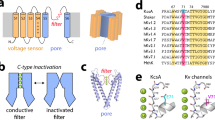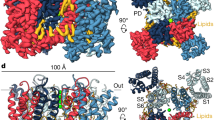Abstract
Gating the ion-permeation pathway in K+ channels requires conformational changes in activation and inactivation gates. Here we have investigated the structural alterations associated with pH-dependent inactivation gating of the KcsA-Kv1.3 K+ channel using solid-state NMR spectroscopy in direct reference to electrophysiological and pharmacological experiments. Transition of the KcsA-Kv1.3 K+ channel from a closed state at pH 7.5 to an inactivated state at pH 4.0 revealed distinct structural changes within the pore, correlated with activation-gate opening and inactivation-gate closing. In the inactivated K+ channel, the selectivity filter adopts a nonconductive structure that was also induced by binding of a pore-blocking tetraphenylporphyrin derivative. The results establish a structural link between inactivation and block of a K+ channel in a membrane setting.
This is a preview of subscription content, access via your institution
Access options
Subscribe to this journal
Receive 12 print issues and online access
$189.00 per year
only $15.75 per issue
Buy this article
- Purchase on Springer Link
- Instant access to full article PDF
Prices may be subject to local taxes which are calculated during checkout





Similar content being viewed by others
References
Hille, B. Ionic Channels of Excitable Membranes 3rd edn. (Sinauer Associates Inc., Sunderland, MA, 2001).
Yellen, G. The moving parts of voltage-gated ion channels. Q. Rev. Biophys. 31, 239–295 (1998).
Jiang, Y. et al. The open pore conformation of potassium channels. Nature 417, 523–526 (2002).
Bean, B.P. The action potential in mammalian central neurons. Nat. Rev. Neurosci. 8, 451–465 (2007).
Starkus, J.G., Kuschel, L., Rayner, M.D. & Heinemann, S.H. Ion conduction through C-type inactivated shaker channels. J. Gen. Physiol. 110, 539–550 (1997).
Starkus, J.G., Kuschel, L., Rayner, M.D. & Heinemann, S.H. Macroscopic Na+ Currents in the “nonconducting” shaker potassium channel mutant W434F. J. Gen. Physiol. 112, 85–93 (1998).
Valiyaveetil, F.I., Leonetti, M., Muir, T.W. & MacKinnon, R. Ion selectivity in a semisynthetic K+ channel locked in the conductive conformation. Science 314, 1004–1007 (2006).
Berneche, S. & Roux, B. A gate in the selectivity filter of potassium channels. Structure 13, 591–600 (2005).
Cordero-Morales, J.F. et al. Molecular determinants of gating at the potassium-channel selectivity filter. Nat. Struct. Mol. Biol. 13, 311–318 (2006).
Cordero-Morales, J.F., Cuello, L.G. & Perozo, E. Voltage-dependent gating at the KcsA selectivity filter. Nat. Struct. Mol. Biol. 13, 319–322 (2006).
Cordero-Morales, J.F. et al. Molecular driving forces determining potassium channel slow inactivation. Nat. Struct. Mol. Biol. 14, 1062–1069 (2007).
Blunck, R., Cordero-Morales, J.F., Cuello, L.G., Perozo, E. & Bezanilla, F. Detection of the opening of the bundle crossing in KcsA with fluorescence lifetime spectroscopy reveals the existence of two gates for ion conduction. J. Gen. Physiol. 128, 569–581 (2006).
Zhou, Y., Morais-Cabral, J.H., Kaufman, A. & MacKinnon, R. Chemistry of ion coordination and hydration revealed by a K+ channel-Fab complex at 2.0Å resolution. Nature 414, 43–48 (2001).
Long, S.B., Campbell, E.B. & MacKinnon, R. Crystal structure of a mammalian voltage-dependent shaker family K+ channel. Science 309, 897–903 (2005).
Long, S.B., Tao, X., Campbell, E.B. & MacKinnon, R. Atomic structure of a voltage-dependent K+ channel in a lipid membrane-like environment. Nature 450, 376–382 (2007).
Lange, A. et al. Toxin-induced conformational changes in a potassium channel revealed by solid-state NMR. Nature 440, 959–962 (2006).
Legros, C. et al. Generating a high affinity scorpion toxin receptor in KcsA-Kv1.3 chimeric potassium channels. J. Biol. Chem. 275, 16918–16924 (2000).
Gradl, S.N., Felix, J.P., Isacoff, E.Y., Garcia, M.L. & Trauner, D. Protein surface recognition by rational design: nanomolar ligands for potassium channels. J. Am. Chem. Soc. 125, 12668–12669 (2003).
Yu, L. et al. Nuclear magnetic resonance structural studies of a potassium channel-charybdotoxin complex. Biochemistry 44, 15834–15841 (2005).
Chill, J.H., Louis, J.M., Miller, C. & Bax, A. NMR study of the tetrameric KcsA potassium channel in detergent micelles. Protein Sci. 15, 684–698 (2006).
Takeuchi, K., Takahashi, H., Kawano, S. & Shimada, I. Identification and characterization of the slowly exchanging pH-dependent conformational rearrangement in KcsA. J. Biol. Chem. 282, 15179–15186 (2007).
Baker, K.A., Tzitzilonis, C., Kwiatkowski, W., Choe, S. & Riek, R. Conformational dynamics of the KcsA potassium channel governs gating properties. Nat. Struct. Mol. Biol. 14, 1089–1095 (2007).
Chill, J.H., Louis, J.M., Delaglio, F. & Bax, A. Local and global structure of the monomeric subunit of the potassium channel KcsA probed by NMR. Biomembranes 1768, 3260–3270 (2007).
Schneider, R. et al. Solid-state NMR spectroscopy applied to a chimeric potassium channel in lipid bilayers. J. Am. Chem. Soc. (in the press).
Cortes, D.M., Cuello, L.G. & Perozo, E. Molecular architecture of full-length KcsA: role of cytoplasmic domains in ion permeation and activation gating. J. Gen. Physiol. 117, 165–180 (2001).
Valiyaveetil, F.I., Zhou, Y. & MacKinnon, R. Lipids in the structure, folding, and function of the KcsA K+ channel. Biochemistry 41, 10771–10777 (2002).
Matthews, E.E., Zoonens, M. & Engelman, D.M. Dynamic helix interactions in transmembrane signaling. Cell 127, 447–450 (2006).
Cuello, L.G., Romero, J.G., Cortes, D.M. & Perozo, E. pH-dependent gating in the Streptomyces lividans K+ channel. Biochemistry 37, 3229–3236 (1998).
Heginbotham, L., LeMasurier, M., Kolmakova-Partensky, L. & Miller, C. Single Streptomyces lividans K+ channels: functional asymmetries and sidedness of proton activation. J. Gen. Physiol. 114, 551–560 (1999).
Luca, S. et al. Secondary chemical shifts in immobilized peptides and proteins: a qualitative basis for structure refinement under Magic Angle Spinning. J. Biomol. NMR 20, 325–331 (2001).
Neal, S., Nip, A.M., Zhang, H. & Wishart, D.S. Rapid and accurate calculation of protein 1H, 13C and 15N chemical shifts. J. Biomol. NMR 26, 215–240 (2003).
Brünger, A.T. et al. Crystallography & NMR system: a new software suite for macromolecular structure determination. Acta Crystallogr. D Biol. Crystallogr. 54, 905–921 (1998).
Lange, A., Luca, S. & Baldus, M. Structural constraints from proton-mediated rare-spin correlation spectroscopy in rotating solids. J. Am. Chem. Soc. 124, 9704–9705 (2002).
Lockless, S.W., Zhou, M. & MacKinnon, R. Structural and thermodynamic properties of selective ion binding in a K+ channel. PLoS Biol. 5, e121 (2007).
Jiang, Y. et al. X-ray structure of a voltage-dependent K+ channel. Nature 423, 33–41 (2003).
Bielecki, A., Kolbert, A.C. & Levitt, M.H. Frequency-switched pulse sequences: homonuclear decoupling and dilute spin NMR in solids. Chem. Phys. Lett. 155, 341–346 (1989).
Dominguez, C., Boelens, R. & Bonvin, A.M.J.J. HADDOCK: a protein-protein docking approach based on biochemical or biophysical information. J. Am. Chem. Soc. 125, 1731–1737 (2003).
Woodhull, A.M. Ionic blockage of sodium channels in nerve. J. Gen. Physiol. 61, 687–708 (1973).
Lenaeus, M.J., Vamvouka, M., Focia, P.J. & Gross, A. Structural basis of TEA blockade in a model potassium channel. Nat. Struct. Mol. Biol. 12, 454–459 (2005).
Seidel, K. et al. Protein solid-state NMR resonance assignments from (13C,13C) correlation spectroscopy. Phys. Chem. Chem. Phys. 6, 5090–5093 (2004).
Baldus, M., Petkova, A.T., Herzfeld, J. & Griffin, R.G. Cross polarization in the tilted frame: assignment and spectral simplification in heteronuclear spin systems. Mol. Phys. 95, 1197–1207 (1998).
Takegoshi, K., Nakamura, S. & Terao, T. 13C-1H dipolar-assisted rotational resonance in magic-angle spinning NMR. Chem. Phys. Lett. 344, 631 (2001).
Fung, B.M., Khitrin, A.K. & Ermolaev, K. An improved broadband decoupling sequence for liquid crystals and solids. J. Magn. Reson. 142, 97–101 (2000).
Schüttelkopf, A.W. & van Aalten, D.M.F. PRODRG: a tool for high-throughput crystallography of protein-ligand complexes. Acta Crystallogr. D Biol. Crystallogr. 60, 1355–1363 (2004).
Delcour, A.H., Martinac, B., Adler, J. & Kung, C. Modified reconstitution method used in patch-clamp studies of Escherichia coli ion channels. Biophys. J. 56, 631–636 (1989).
Schrempf, H. et al. A prokaryotic potassium ion channel with two predicted transmembrane segments from Streptomyces lividans. EMBO J. 14, 5170–5178 (1995).
Morris, A.L., MacArthur, M.W., Hutchinson, E.G. & Thornton, J.M. Stereochemical quality of protein structure coordinates. Proteins 12, 345–364 (1992).
Acknowledgements
Technical assistance by B. Angerstein is gratefully acknowledged. This work was funded in part by the Deutsche Forschungsgemeinschaft (DFG; Ba 1700/9-1, Be 2345/5-1, Po 137/38-1), by a PhD fellowship to C.A. from the Stiftung Stipendien-Fonds of the Verband der Chemischen Industrie, and by a PhD fellowship to R.S. from the DFG graduate school 782 'Spectroscopy and Dynamics of Molecular Coils and Aggregates'. We are indebted to R. Wagner (University of Osnabrück, Germany) for invaluable support in context of the lipid-bilayer reconstitution experiments. We are grateful to R. Riek for providing solution-state NMR resonance assignments of KcsA constructs in micelles.
Author information
Authors and Affiliations
Corresponding authors
Supplementary information
Supplementary Text and Figures
Supplementary Figures 1–8, Supplementary Table 1 and Supplementary Methods (PDF 521 kb)
Rights and permissions
About this article
Cite this article
Ader, C., Schneider, R., Hornig, S. et al. A structural link between inactivation and block of a K+ channel. Nat Struct Mol Biol 15, 605–612 (2008). https://doi.org/10.1038/nsmb.1430
Received:
Accepted:
Published:
Issue Date:
DOI: https://doi.org/10.1038/nsmb.1430
This article is cited by
-
Shifts in the selectivity filter dynamics cause modal gating in K+ channels
Nature Communications (2019)
-
Site-specific ion occupation in the selectivity filter causes voltage-dependent gating in a viral K+ channel
Scientific Reports (2018)
-
Synchronization behavior of coupled neuron circuits composed of memristors
Nonlinear Dynamics (2017)
-
Lipid bilayer-bound conformation of an integral membrane beta barrel protein by multidimensional MAS NMR
Journal of Biomolecular NMR (2015)
-
Cortisone and hydrocortisone inhibit human Kv1.3 activity in a non-genomic manner
Naunyn-Schmiedeberg's Archives of Pharmacology (2015)



